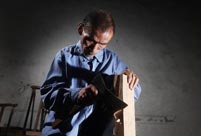

BEIJING, March 24 -- The Dutch collector who presently possesses the Buddha statue with a mummified monk inside should be clearer on how it was acquired, as powerful evidences from China have all pointed to the strong possibility that it was stolen from China's Fujian Province.
On Monday, the private collector, who had remained reticent when this event kept fermenting for several weeks, responded to the hailstorm of questions and doubts for the first time by a written statement addressing to Xinhua.
In the statement, the present holder of the statue said that he or she bought it in 1996, from another collector who managed to acquire the Buddha statue from the end of 1994 to the beginning of 1995 in Hong Kong. The statement also said that the previous "owner" acquired the statue from a certain Chinese artist friend.
Obviously, the account of the statement is still too vague. Actually, all the details provided so far only make the statue's elusive travel from China to the Netherlands even more suspicious.
This is because it failed to clarify one key point: the validity of the process to procure the Buddha statue.
The statement claimed that possession of the statue was shifted twice before the current holder acquired it, while no specific dates were mentioned. If one person buys a precious piece of artifacts, people usually would suppose that this person must keep detailed files where the exact dates can be found.
The Cultural Relics Appraisal Center of China's Fujian Province has recently sent experts to Yangchun Village and found photos, artifacts, and historical documentation suggesting the mummy hidden inside of the statue was an ancestor of the local clan.
The center says villagers have been worshiping a similar statue since the 12th century until it went missing from the temple in 1995.
Though the statement claimed that the collector first saw the statue in mid-1995, and the previous holder possessed it already in 1994-1995, which were both earlier than the Chinese villagers found it missing, the vague account cannot refute the compelling evidences found by Chinese experts.
Moreover, one moral principle that binds art and antique collectors is to not to buy stolen pieces, because antiques, along with any historical artifacts, are with sentiment values.
But without clarifying the identity of the anonymous "Chinese artist friend," the source of the statute has left too much room for speculations.
The Dutch collector referred himself or herself as a veteran art connoisseur of Chinese arts and antiques, so he or she should know better than most people that buying a stolen piece of Chinese antique is not only illegal, but would also hurt the feelings of Chinese people.
Neither reticence nor word play can validate an illegal possession. Now as China has started the procedure to retrieve the Buddha statue, the Dutch collector would eventually have to provide clear and concrete evidences if he or she has any.
 J-11 fighters in air exercise
J-11 fighters in air exercise Beauties dancing on the rings
Beauties dancing on the rings Attendants-to-be join Mr. & Miss Campus Contest
Attendants-to-be join Mr. & Miss Campus Contest Beijing's toughest anti-smoking law takes effect
Beijing's toughest anti-smoking law takes effect Family lives in cave for about 50 years in SW China
Family lives in cave for about 50 years in SW China PLA soldiers operating vehicle-mounted guns in drill
PLA soldiers operating vehicle-mounted guns in drill Blind carpenter in E China's Jiangxi
Blind carpenter in E China's Jiangxi China hosts overseas disaster relief exercise for the first time
China hosts overseas disaster relief exercise for the first time 20 pairs of twins who will become flight attendants in Sichuan
20 pairs of twins who will become flight attendants in Sichuan Obama is sowing discontent in S.China Sea
Obama is sowing discontent in S.China Sea Rescuers work through night to reach cruise ship survivors
Rescuers work through night to reach cruise ship survivors Driving through limbo
Driving through limbo Facing down MERS
Facing down MERSDay|Week